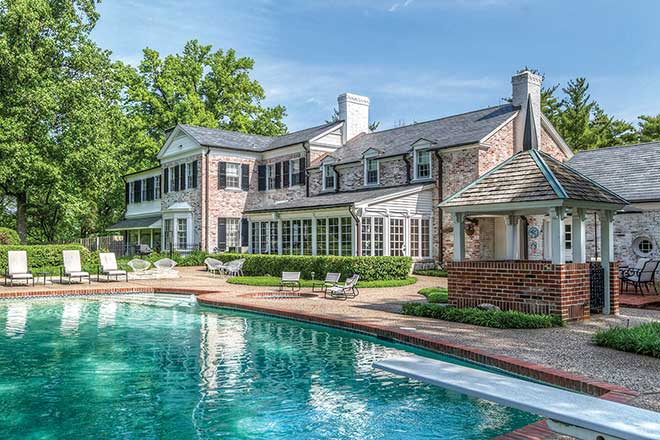The 30 Best Places to Live in Iowa: Top Cities and Towns

Iowa offers residents a unique combination of affordable living, strong communities, and economic stability that makes it an attractive option for families, young professionals, and retirees alike.
The state consistently ranks well for quality of life factors including low crime rates, excellent schools, and access to both urban amenities and outdoor recreation opportunities.
This comprehensive guide examines the top 30 cities and towns across Iowa, evaluating each location based on factors like cost of living, employment opportunities, educational resources, and community amenities.
From larger metropolitan areas like Des Moines and Cedar Rapids to charming smaller communities such as Pella and Decorah, each location offers distinct advantages for different lifestyle preferences and needs.
Here are the 30 best places to live in Iowa:
30. Storm Lake
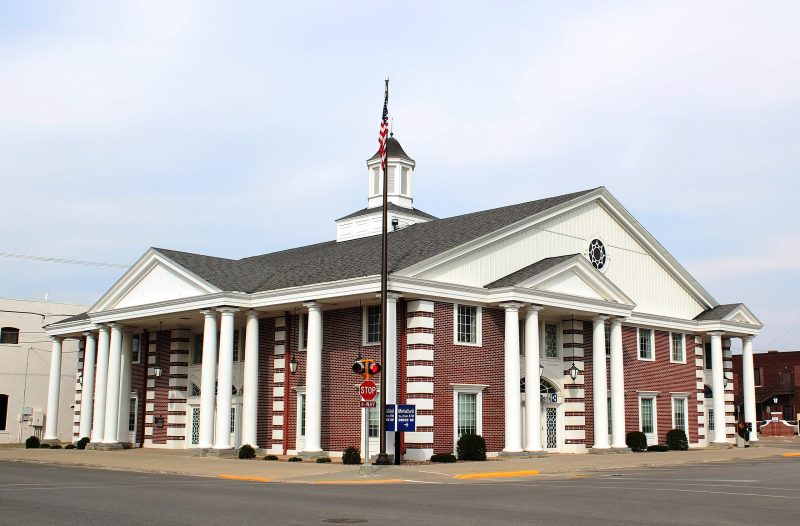
Storm Lake offers residents an attractive combination of affordable living and small-town charm in northwest Iowa. The city sits alongside the natural lake that gives it its name.
Housing costs remain significantly below national averages. The cost of living is nearly 26% lower than the U.S. average, making it accessible for families and retirees.
Crime rates stay notably low for both violent and property crimes. This contributes to the community’s reputation as a safe place to raise families.
The lakefront neighborhoods attract residents who enjoy water activities and fishing. These areas provide scenic views and recreational opportunities throughout the year.
Storm Lake maintains a strong sense of community while offering essential amenities and services. The city balances rural tranquility with modern conveniences for its residents.
29. Decorah
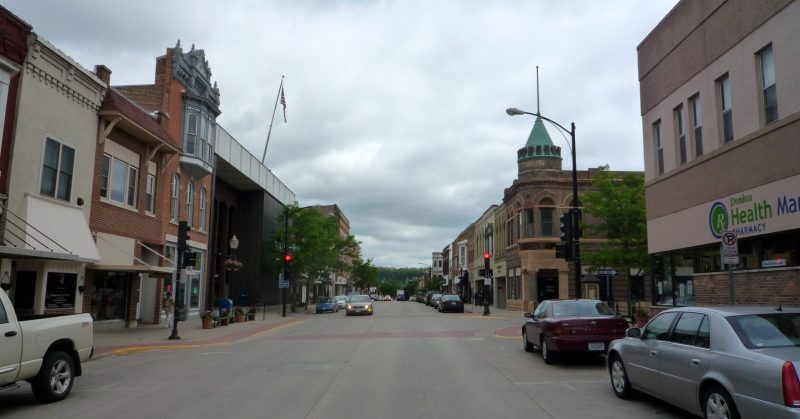
Decorah sits in northeastern Iowa with a population of approximately 7,600 residents. The city offers residents a sparse suburban atmosphere where most people own their homes.
The community features numerous bars and coffee shops throughout the downtown area. Residents enjoy access to the scenic 11-mile Trout Run Trail, which loops through town and passes along the Upper Iowa River and limestone bluffs.
The poverty rate stands at 10%, which is below the national average. The typical household earns $55,920 annually, though this falls short of the national median income.
Decorah provides strong community connections and outdoor recreation opportunities. The area maintains a generally affordable cost of living compared to larger metropolitan areas.
Winter weather presents challenges for residents, with cold temperatures lasting several months. Job opportunities remain limited due to the city’s small size and rural location.
28. Carroll
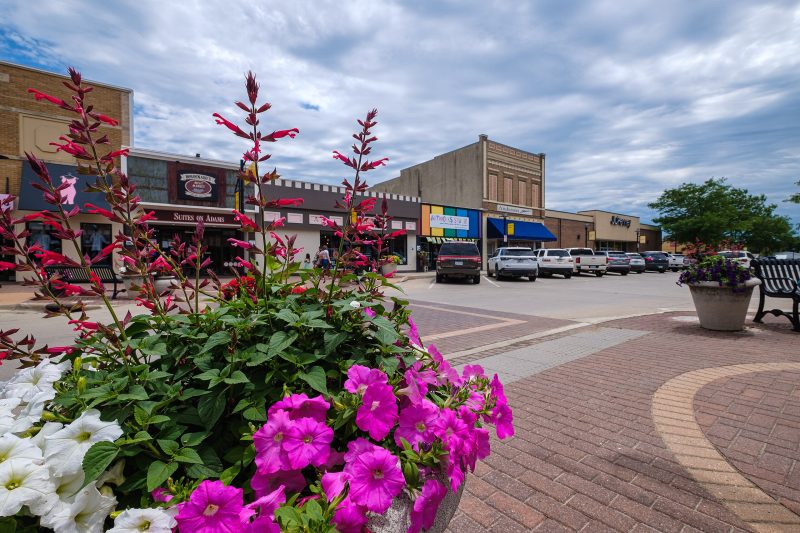
Carroll offers residents an affordable lifestyle with living costs nearly 18% below the national average. The city maintains a population of approximately 10,000 people, creating a close-knit community atmosphere.
The town earned a livability score of 78 out of 100 on rankings sites. This places Carroll among Iowa’s top-rated cities for overall quality of life.
Housing costs remain below the state average of $182,666. The local poverty rate sits at 7.7%, which is 45% lower than the national average.
Carroll provides diverse housing options despite its smaller size. The surrounding landscape features rolling hills and green fields that offer outdoor recreation opportunities.
The typical household earns $49,555 annually. Residents enjoy access to local amenities while benefiting from the warmth of small-town living.
27. Burlington
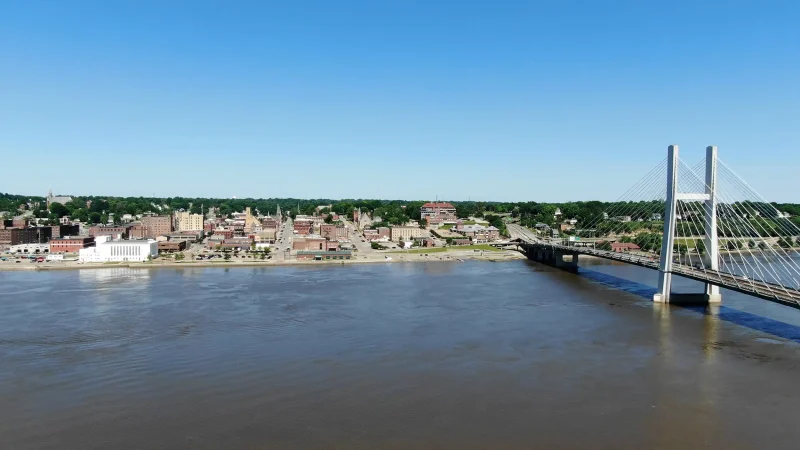
Burlington stands as a historic river town along the Mississippi River in southeastern Iowa. The city offers residents a blend of historical charm and modern amenities.
The cost of living in Burlington ranks favorably compared to many Iowa communities. Housing options vary significantly across different neighborhoods, with some areas commanding higher home values than others.
Burlington receives strong ratings for amenities and weather conditions. The city provides decent job opportunities, though income requirements may be higher for comfortable living.
Crime rates fall within acceptable ranges for the area. The community appeals to retirees and families seeking small-town atmosphere with river access.
Educational facilities and local services support residents’ daily needs. Burlington’s location provides access to larger metropolitan areas while maintaining its distinctive small-city character along Iowa’s eastern border.
26. Spirit Lake
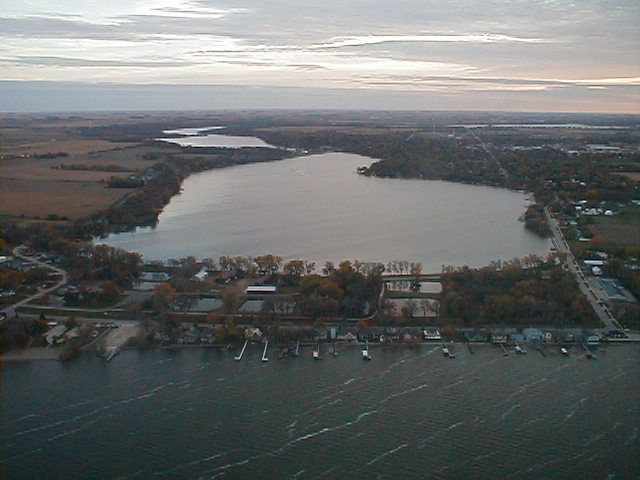
Spirit Lake stands as one of Iowa’s premier lakeside communities with a population of 5,469 residents. The town offers a dense suburban atmosphere where most residents own their homes.
Located in Dickinson County, Spirit Lake provides abundant recreational opportunities. The community features numerous bars, restaurants, and parks for residents to enjoy.
The area receives high safety ratings and maintains a low unemployment rate. Educational opportunities are strong throughout the region.
Spirit Lake’s cost of living remains affordable compared to national averages. Home prices align closely with Iowa’s state average of $182,666.
The local economy demonstrates stability with diverse employment options. Residents benefit from the combination of small-town charm and lakeside living.
Spirit Lake earned a livability score of 80 out of 100, ranking it among the top places to live in Iowa. The community successfully balances affordability with quality of life amenities.
25. Pella
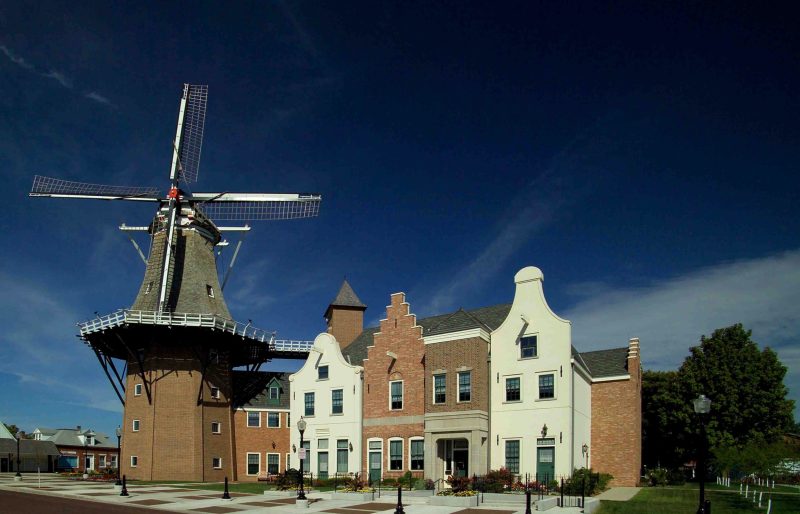
Pella stands out as one of Iowa’s most desirable communities with a population of approximately 10,600 residents. The city earned recognition as the #3 Best Place to Live in the US by USA TODAY in 2019.
Founded by Dutch immigrants in 1847, Pella maintains its cultural heritage while offering modern amenities. The community is known as the “Windmill City” due to its connection to wind energy development.
Residents enjoy a low poverty rate of 2.7%, significantly below the national average. The typical household earns $75,848 annually, exceeding the national median income of $67,500.
Pella provides diverse housing options across new and established neighborhoods. Most residents own their homes in this dense suburban environment with numerous parks throughout the city.
The community attracts young professionals and maintains a conservative political climate. Pella consistently ranks among Iowa’s top places to live.
24. Keokuk
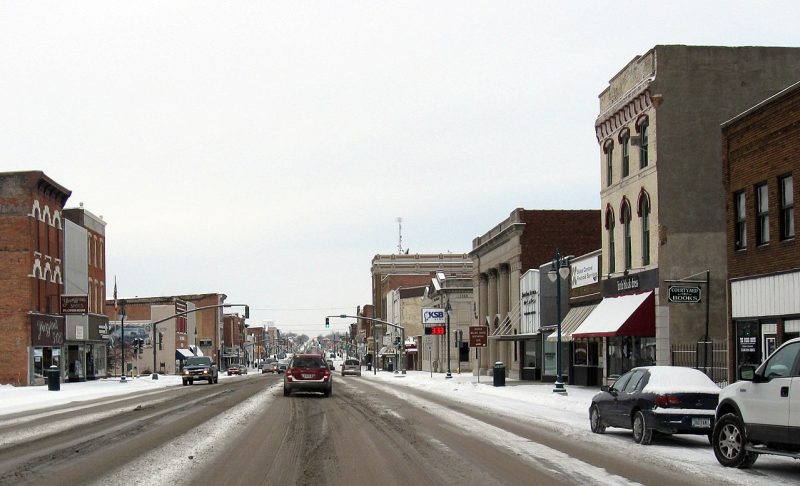
Keokuk sits along the Mississippi River in southeastern Iowa with a population of approximately 10,000 residents. The city offers an affordable cost of living with a median home value of $90,764, significantly below Iowa’s state average.
The median household income in Keokuk is $47,450. Housing costs remain among the most attractive features for potential residents seeking budget-friendly options.
Keokuk ranks 31st out of 178 Iowa places for lowest cost of living. The city receives a livability score of 72 out of 100, placing it at #225 within Iowa.
The Mississippi River location provides natural beauty and recreational opportunities. Keokuk maintains small-town charm while offering essential amenities and services.
The city attracts retirees and families looking for affordable housing in a river community setting. Crime rates and quality of life factors contribute to its appeal among Iowa’s smaller cities.
23. Oskaloosa
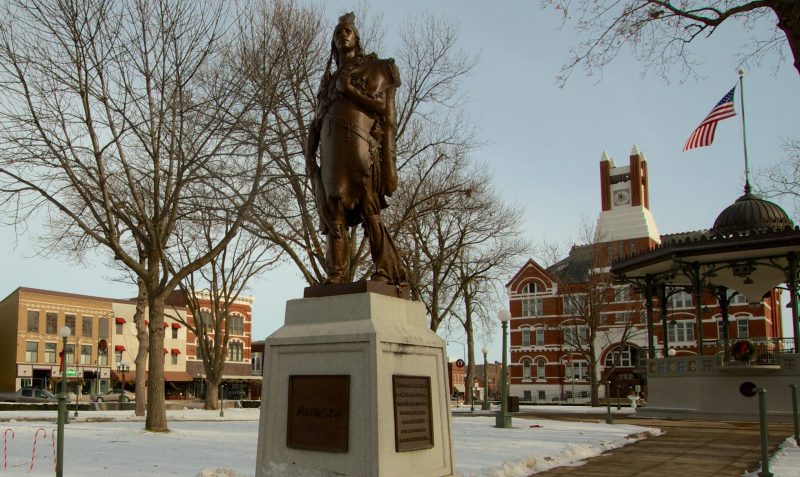
Oskaloosa sits in Mahaska County with a population of approximately 11,700 residents. The city offers affordable housing with a median home price of $117,800, well below Iowa’s state average.
The community features a vibrant downtown area with shopping, dining, and entertainment options. Parks, trails, and nearby lakes provide outdoor recreation opportunities for residents.
Home values have appreciated 2.6% in the past year, indicating a stable housing market. The typical household earns $49,856 annually, though this falls below the national median.
Oskaloosa ranks among Iowa’s places with lower cost of living, making it attractive for budget-conscious residents. The city maintains a small-town atmosphere with strong community connections.
The area appeals to families, professionals, and retirees seeking affordable living in central Iowa. Various neighborhoods offer different housing styles and price points throughout the city.
22. Fort Dodge
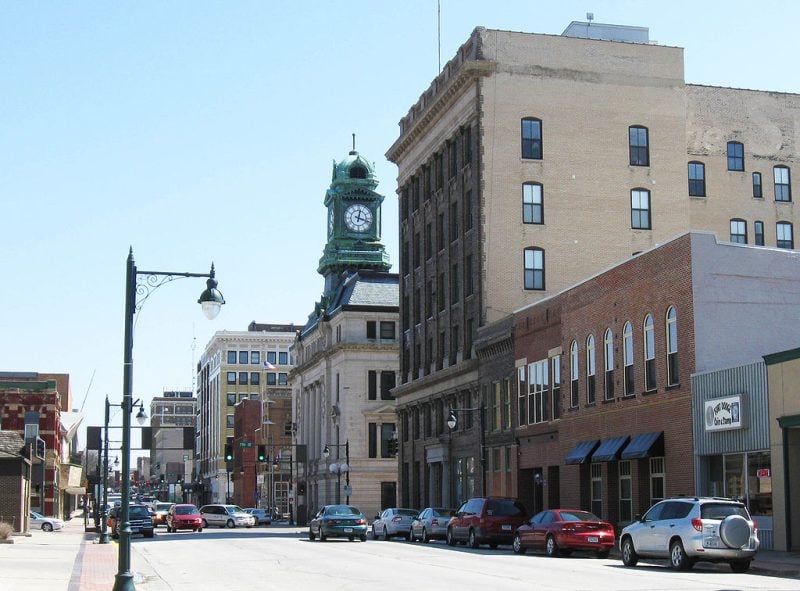
Fort Dodge stands out as one of Iowa’s safest cities with exceptionally low crime rates. This Webster County city provides residents with security and peace of mind for families and professionals alike.
The community offers a blend of urban convenience and suburban comfort. Housing options cater to diverse needs, from young families to retirees seeking affordable living arrangements.
Fort Dodge maintains a strong commitment to education and recreational opportunities. The city features quality public schools and various community amenities that enhance daily life.
Economic stability characterizes the local job market. Residents benefit from reasonable cost of living expenses compared to larger metropolitan areas throughout the state.
The city’s location in central Iowa provides convenient access to other major cities while maintaining its distinct community character.
21. Grinnell
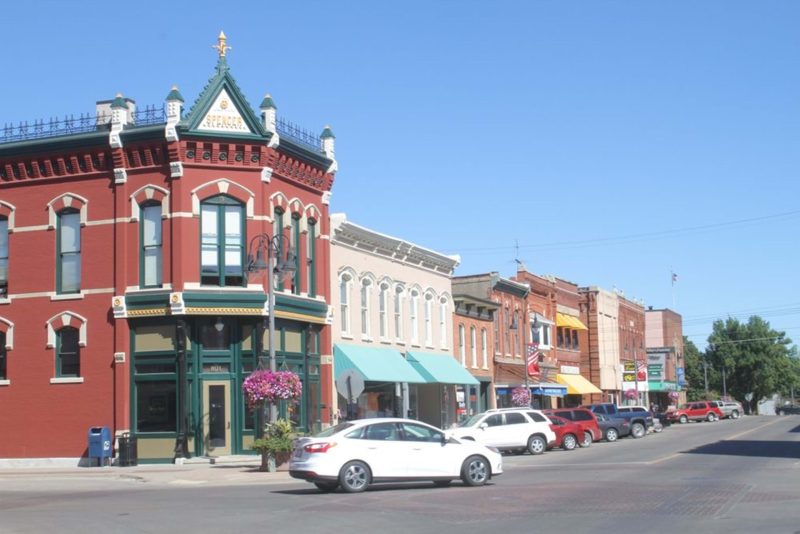
Grinnell sits in Poweshiek County with a population of approximately 9,500 residents. The city ranks as one of Iowa’s better places to live according to multiple housing market analyses.
The community offers a sparse suburban feel where most residents own their homes. Grinnell’s downtown area provides numerous bars, restaurants, and parks for residents to enjoy.
Housing costs remain reasonable compared to national averages. The typical household earns $50,668 annually, which is below the national median but reflects the area’s lower cost of living.
Grinnell scores well in walkability, crime rates, and education categories. The city maintains a livability score of 76 out of 100 according to ranking systems.
The poverty rate stands at 11%, which is notably lower than the national average. This college town combines rural charm with urban amenities, attracting families, professionals, and retirees seeking a close-knit community atmosphere.
20. Ottumwa
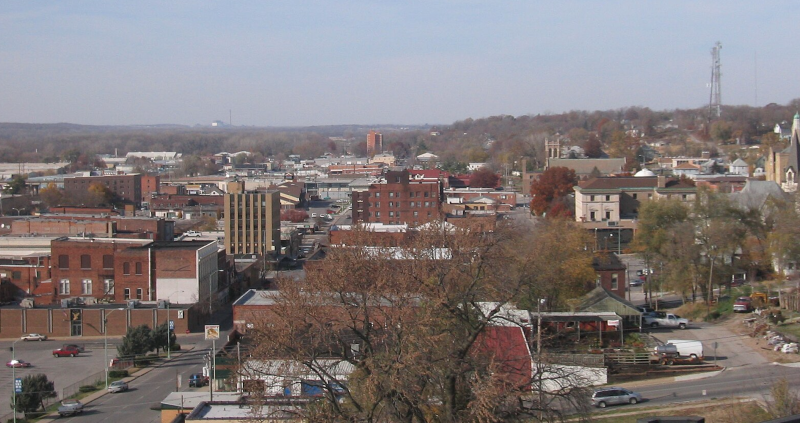
Ottumwa sits in Wapello County with a population of approximately 25,000 residents. The city offers a sparse suburban feel where most residents own their homes.
The cost of living ranks among the lower tiers nationally. Typical households earn around $42,400 annually, which falls below the national median income.
Housing options vary significantly across different neighborhoods within the city. The real estate market reflects this disparity in home values and neighborhood quality.
Families make up a large portion of the population. Political leanings tend toward conservative viewpoints among residents.
Outdoor recreation opportunities include fishing, hunting, and hiking trails throughout the area. Several parks provide spaces for leisure activities and community gatherings.
The poverty rate stands at 18.1%, which exceeds the national average by 29 percent.
19. Muscatine
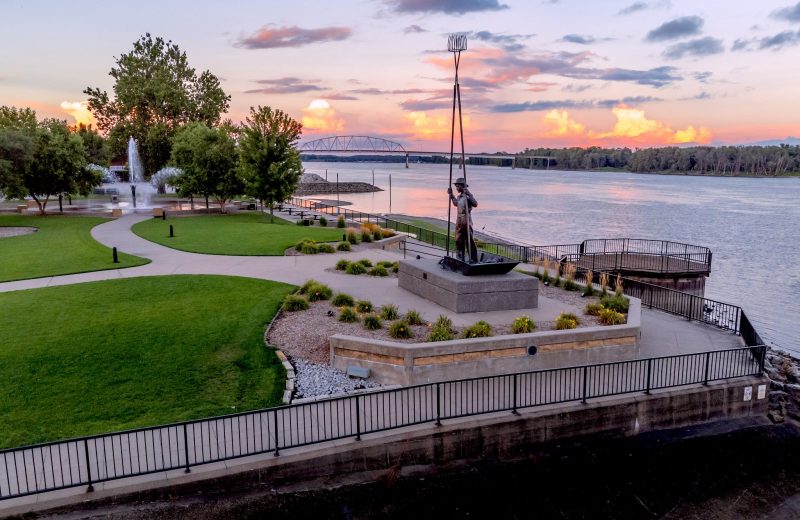
Muscatine sits along the Mississippi River in eastern Iowa with a population of 23,661 residents. The city offers a blend of small-town charm and modern amenities that attracts families and retirees.
Downtown Muscatine provides vibrant urban living options. South Muscatine offers quieter residential neighborhoods for those seeking a more serene environment.
The typical household earns $53,768 annually, which is below the national median of $67,500. The poverty rate stands at 14.3%, slightly higher than the national average.
Housing options vary significantly across different neighborhoods. The market shows notable disparities in home values throughout the city.
Residents benefit from access to the Mississippi River and various local amenities. The community maintains lower crime rates in several neighborhoods, contributing to quality of life for many families.
18. Marshalltown
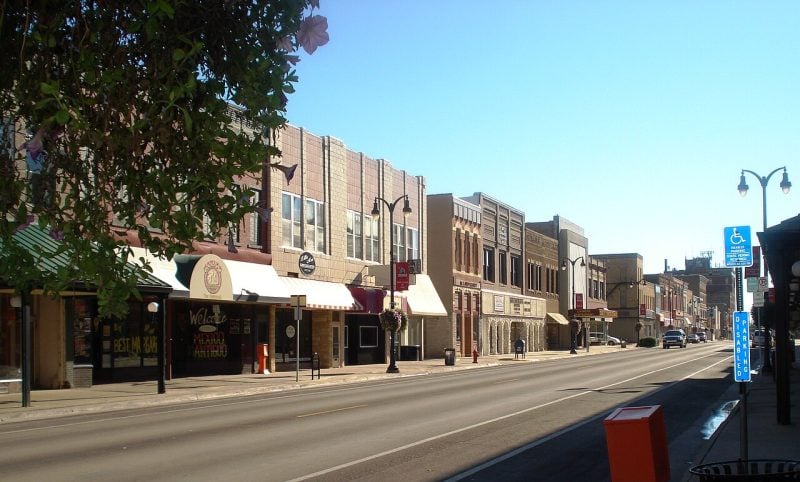
Marshalltown sits in central Iowa with approximately 25,000 to 27,000 residents. The city offers a small-town atmosphere while providing various amenities for different age groups.
The cost of living ranks significantly lower than national averages. Housing options accommodate families, singles, and retirees across different price ranges.
Residents enjoy outdoor activities including camping and hiking opportunities. The Cultural & Entertainment District provides local attractions and events throughout the year.
The city maintains a reputation for safety and community friendliness. Schools and family-oriented amenities make it suitable for those raising children.
Marshalltown receives a livability score of 75 out of 100, ranking in the 89th percentile nationally. This rating considers factors like amenities, employment opportunities, and overall quality of life.
The city serves as the county seat of Marshall County. Its central Iowa location provides reasonable access to larger metropolitan areas when needed.
17. Dubuque
Dubuque sits along the Mississippi River in northeast Iowa, offering residents scenic river views and historic charm. The city provides a calm-paced lifestyle that appeals to families and retirees alike.
The housing market offers diverse options within welcoming neighborhoods. Home values vary significantly across different areas of the city.
Dubuque ranks sixth among the best places to live in Iowa. The city maintains an employment rate above the national average, supporting a stable job market.
Residents enjoy year-round activities and amenities throughout the community. The city combines small-town atmosphere with access to cultural attractions and outdoor recreation.
Crime rates tend to be lower in the more desirable neighborhoods. Public schools serve the community with established educational programs for local families.
16. Mason City
Mason City ranks among Iowa’s most livable communities with a population of 27,135 residents. The city offers a sparse suburban atmosphere where most residents own their homes.
Housing affordability stands out as a major advantage. Home prices fall below Iowa’s state average of $182,666, making homeownership accessible for many families.
The city earned strong ratings across key livability metrics. Mason City received an 8.5/10 for housing, 9.6/10 for cost of living, and 8/10 for crime and safety from quality of life assessments.
Residents enjoy abundant parks and recreational amenities throughout the area. The city attracts both young professionals and retirees seeking affordable living options.
Mason City’s location in Cerro Gordo County provides convenient access to regional attractions. Low crime rates contribute to the community’s appeal for families and individuals prioritizing safety.
15. Council Bluffs
Council Bluffs sits across the Missouri River from Omaha, Nebraska, offering residents affordable living with urban amenities nearby. The city has a population of 62,564 and maintains a dense suburban feel.
Home prices average around $182,666, which aligns with Iowa’s state average but costs significantly less than similar-sized cities elsewhere. Most residents own their homes in this community.
The Fairmont Park neighborhood features historic homes and tree-lined streets. Lincoln/Fairview provides diverse housing options with easy downtown access.
Twin City offers affordable homes and strong community connections. These areas represent some of the most desirable places to live based on market demand.
Council Bluffs provides abundant parks and above-average public schools. The city attracts many families seeking small-town charm with metropolitan conveniences just minutes away in Omaha.
14. Waterloo
Waterloo stands as the largest city in Black Hawk County, combining urban amenities with small-town appeal. The city offers residents a unique blend of metropolitan conveniences and community atmosphere.
Housing quality varies significantly across different neighborhoods in Waterloo. The best residential areas are typically determined by median home values and market demand from potential buyers.
Crime rates and quality of life factors differ throughout the city’s various districts. Residents can find neighborhoods that match their specific preferences and budget requirements.
The city provides job opportunities and local amenities that support families and working professionals. Public schools serve the community alongside various recreational and cultural attractions.
Waterloo’s location in Iowa offers residents access to both urban resources and the benefits of living in a mid-sized community.
13. Waukee
Waukee stands out as a rapidly growing suburb of Des Moines with a population of approximately 27,000 residents. The city attracts new residents at a rate of six people per day due to its strong amenities and excellent schools.
The Waukee Community School District serves as a major draw for families considering relocation. This top-rated district contributes significantly to the area’s appeal for parents seeking quality education.
Housing remains relatively affordable despite high demand. The city issued nearly 600 single-family housing permits last year, setting a new record for residential development.
Waukee offers a dense suburban atmosphere with numerous parks and recreational opportunities. Most residents own their homes, creating stable neighborhoods throughout the community.
The typical household earns $94,371 annually, well above the national median. The poverty rate sits at just 3.3%, significantly lower than national averages.
12. Johnston
Johnston stands out as one of Iowa’s premier suburban communities. This Des Moines suburb houses 24,196 residents and consistently ranks among the state’s best places to live.
The city offers a dense suburban atmosphere where most residents own their homes. Johnston provides numerous coffee shops and parks that enhance the community experience.
Location plays a key role in Johnston’s appeal. Its proximity to Des Moines gives residents access to Iowa’s cultural and economic center while maintaining a quieter suburban lifestyle.
The community benefits from strong fundamentals across multiple categories. Crime rates, public schools, cost of living, and real estate values all contribute to Johnston’s high rankings.
Johnston attracts families seeking quality amenities and a stable environment. The combination of suburban comfort and urban accessibility makes it particularly appealing to those working in the Des Moines metro area.
11. Clive
Clive stands out as one of Iowa’s premier communities with a population exceeding 18,000 residents. The city earns a livability score of 74 out of 100 according to ratings data.
Cost of living remains nearly 10% below the national average. This affordability factor attracts families and professionals seeking quality living without excessive expenses.
Crime rates in Clive fall significantly lower than national statistics. Residents benefit from enhanced safety and security in their neighborhoods.
The city offers big-city conveniences while maintaining a smaller community atmosphere. Amenities and facilities provide residents with modern lifestyle options.
Home prices in Clive exceed Iowa’s state average of $182,666. The higher property values reflect the desirability and quality of the area’s neighborhoods.
Clive combines suburban comfort with accessible urban amenities, making it attractive for various demographics seeking quality living in Iowa.
10. Bettendorf
Bettendorf stands as one of Iowa’s premier suburban communities with a population of 39,297 residents. The city sits in Scott County as a suburb of Davenport.
Most residents own their homes in this dense suburban environment. The community offers numerous bars and parks for recreation and entertainment.
Bettendorf maintains lower crime rates compared to many Iowa cities. The area features higher quality of life standards that attract families and professionals.
The city boasts strong educational resources with seven elementary schools and two middle schools. Public schooling receives high marks from residents and education rankings.
Employment opportunities remain steady with low unemployment rates. The job market supports various industries and career paths.
Housing values vary significantly across different neighborhoods within the city. Market demand drives prices in the most desirable residential areas.
Bettendorf experiences a humid continental climate with four distinct seasons. Weather patterns change quickly throughout the year, typical of the Midwest region.
9. Urbandale
Urbandale stands as one of Iowa’s premier suburban communities with a population of 46,026. This Des Moines suburb consistently earns recognition for its exceptional livability.
The city ranks 14th nationally for livability with a score of 75 out of 100. Money magazine has featured Urbandale in its Best Places to Live rankings.
Residents enjoy excellent public schools and extensive park systems. The community offers numerous bike trails and coffee shops throughout the area.
Most residents own their homes in this dense suburban environment. Housing remains affordable compared to many metropolitan areas.
Urbandale provides urban amenities while maintaining suburban comfort. The city combines quality education, recreational opportunities, and reasonable cost of living.
Crime rates remain low across most neighborhoods. Home values vary significantly between different areas of the city.
8. Ankeny
Ankeny earned national recognition as the 18th best place to live in the United States according to U.S. News & World Report’s 2025-2026 rankings. The city claimed the top spot among Iowa communities and ranked 11th among the best small cities nationwide.
This Des Moines suburb boasts a population of approximately 64,744 residents. The typical household earns $89,484 annually, significantly higher than the national median of $67,500.
The city maintains a low poverty rate of 4.6%, which is 67% below the national average. Ankeny’s ranking reflects strong performance in quality of life, job market conditions, and overall desirability.
Located in Polk County within the Des Moines-West Des Moines metro area, Ankeny offers proximity to Iowa’s capital region. The evaluation process considered over 850 cities across multiple factors including housing value and neighborhood quality.
7. West Des Moines
West Des Moines ranks among Iowa’s premier communities with a population of nearly 70,000 residents. The city offers an urban-suburban blend that attracts families and professionals alike.
Valley Junction stands out as the historic downtown area. It features charming shops and well-preserved homes that reflect the city’s heritage.
Glen Oaks provides upscale living centered around its golf course community. This neighborhood appeals to residents seeking premium amenities and recreational opportunities.
Jordan Creek represents one of the city’s most popular areas. The neighborhood features newer developments and proximity to major shopping centers.
West Glen Town Center offers mixed-use development with urban conveniences. Residents enjoy walkable access to dining, shopping, and entertainment options.
The city maintains excellent public schools and low crime rates. These factors contribute to its family-friendly reputation throughout the Des Moines metro area.
6. Ames
Ames consistently ranks among Iowa’s top communities for quality of life. The city earned recognition as the 15th best place to live nationally according to Livability.com.
Home to Iowa State University, Ames hosts nearly 32,000 students from around the world. This creates a vibrant cultural environment with diverse dining and entertainment options.
The city offers excellent public schools and maintains low crime rates. Housing options range from historic homes in Old Town to newer developments in Somerset.
Ames provides strong job opportunities and a stable economy. The presence of the university creates a well-educated workforce and entrepreneurial atmosphere.
Residents enjoy numerous parks, coffee shops, and recreational facilities. The community blends suburban comfort with urban amenities effectively.
5. Coralville
Coralville stands out as one of Iowa’s premier places to live. The city offers residents an ideal blend of big-city amenities and small-town charm.
Located just 5-10 minutes from Iowa City and the University of Iowa, Coralville provides easy access to cultural activities and world-class healthcare. The proximity creates unique opportunities without the typical college town atmosphere.
Housing costs remain 27% below the national average. This affordability makes Coralville particularly attractive compared to nearby Iowa City.
The community attracts families and professionals seeking a quieter, cleaner environment. Residents enjoy diverse recreational opportunities including hiking trails, water activities, and numerous dining and shopping options.
Coralville maintains an educated population and diverse economy. The city successfully balances growth with livability, creating an environment that appeals to various demographics.
4. Davenport
Davenport ranks as the 43rd best place to live in the United States according to U.S. News & World Report’s 2025-26 rankings. The city stands out for its exceptional affordability compared to other top-rated locations.
As the largest city in the Quad Cities metropolitan area, Davenport offers both urban and suburban living options along the Mississippi River. The collaborative nature of the Quad Cities provides residents with amenities typically found in much larger metropolitan areas.
The city maintains a high standard of living with various attractions and activities for residents. Young professionals and growing families both find suitable opportunities in Davenport’s diverse community.
Davenport’s recognition as an All-Star Community reflects its balanced approach to quality of life and economic opportunity. The city combines historical charm with modern convenience throughout its neighborhoods.
3. Des Moines
Des Moines stands as Iowa’s capital and largest city, offering residents a compelling mix of urban amenities and Midwestern charm. The city has earned recognition from U.S. News & World Report as a top metropolitan area for quality of life.
The local economy provides diverse employment opportunities across insurance, finance, and agriculture sectors. Job growth remains steady, attracting young professionals and families to the region.
Housing costs stay reasonable compared to other major metropolitan areas. Neighborhoods range from historic districts to modern suburban developments, accommodating various budgets and lifestyle preferences.
The city maintains excellent public schools and numerous parks throughout the metro area. Crime rates remain relatively low for a city of its size.
Des Moines offers cultural attractions, dining options, and recreational activities that rival much larger cities. The combination of affordability and amenities makes it attractive for long-term residents.
2. Cedar Rapids
Cedar Rapids ranks as Iowa’s second-largest city and offers residents a blend of urban amenities with suburban comfort. The city earned recognition as the 11th best place to live in the Midwest according to Livability.com’s rankings.
Housing remains affordable with average home prices around $187,000. This cost aligns closely with Iowa’s state average of $182,666, making homeownership accessible for many residents.
The city provides diverse recreational opportunities including golf courses, swimming pools, museums, and theaters. Cedar Rapids also features quality healthcare facilities with several major hospitals serving the community.
Residents report high quality of life ratings despite the reasonable cost of living. The city attracts people seeking affordable housing without sacrificing access to cultural and recreational activities.
Cedar Rapids combines practical living costs with solid infrastructure and amenities, positioning it as a strong choice for Iowa residents.
1. Iowa City
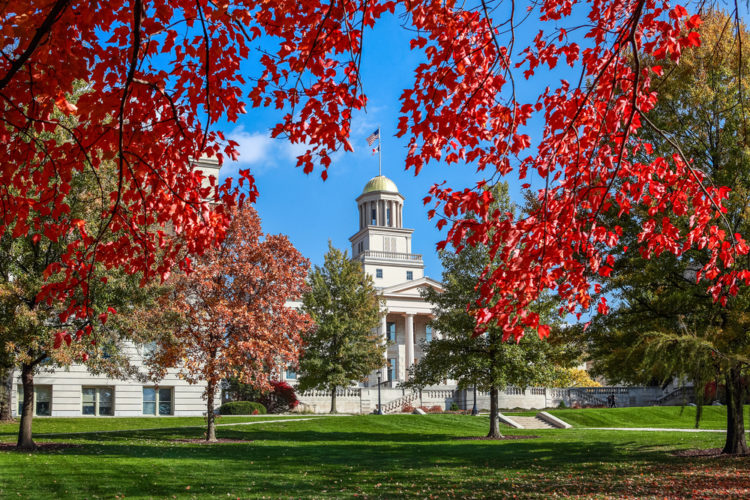
Iowa City stands as one of Iowa’s premier destinations for residents seeking quality of life and cultural richness. The city consistently ranks among America’s top places to live.
Home to the University of Iowa, this vibrant community offers diverse neighborhoods that cater to different lifestyles. The Peninsula Neighborhood provides walkable streets with varied housing options.
Manville Heights attracts residents with its upscale atmosphere near downtown and the university. The historic Northside district features charming homes and maintains a creative, bohemian character.
University Heights operates as a small independent city within Iowa City’s boundaries. This area draws university faculty and staff who value its quiet residential environment.
The city balances college town energy with family-friendly amenities. Residents benefit from cultural events, dining options, and recreational opportunities that stem from the university’s presence while enjoying stable neighborhoods beyond campus areas.
Key Factors That Make Iowa a Great Place to Live
Iowa consistently ranks among the most affordable states in America while maintaining strong economic fundamentals and tight-knit communities. The state offers residents financial stability through low living costs, diverse employment opportunities, and exceptionally safe neighborhoods.
Cost of Living Advantages
Iowa ranks among the top 10 most affordable states in the United States. Housing costs remain significantly below national averages, with median home prices allowing families to purchase quality homes without financial strain.
Housing affordability stands out as Iowa’s strongest economic advantage. Residents can find homes across all price ranges, from starter properties to luxury residences. Property taxes remain reasonable compared to coastal states.
Everyday expenses like groceries, utilities, and transportation costs are notably lower than national averages. Gas prices typically run 10-15 cents below the national average.
Healthcare costs in Iowa are substantially lower than most states. Medical services and prescription medications cost significantly less, making healthcare accessible for families and retirees.
The state’s low cost of living allows residents to save more money for retirement, education, and recreational activities. Many families can live comfortably on single incomes.
Iowa’s Economic Strength
Iowa maintains a diversified economy built on agriculture, manufacturing, insurance, and renewable energy sectors. Major employers include Principal Financial Group, Casey’s General Stores, and Hy-Vee supermarkets.
The state leads the nation in wind energy production, generating over 60% of its electricity from wind turbines. This renewable energy focus attracts clean technology companies and creates green jobs.
Unemployment rates in Iowa consistently stay below national averages. The state weathered recent economic downturns better than many regions due to its economic diversity.
Agriculture remains a cornerstone industry, with Iowa producing more corn, soybeans, and pork than most other states. Food processing companies provide stable employment opportunities throughout rural areas.
Business climate rankings place Iowa in the top tier for startup-friendly policies and low regulatory burdens. The state offers tax incentives for new businesses and expanding companies.
Community and Safety
Iowa communities maintain exceptionally low crime rates compared to national averages. Violent crime occurs infrequently, and property crime rates remain well below most other states.
Small towns across Iowa foster strong community connections where neighbors know each other. Local businesses thrive with support from residents who prefer shopping locally.
Family-friendly amenities are abundant throughout the state. Communities offer excellent public parks, bike trails, recreation centers, and youth sports programs.
Educational systems in Iowa rank among the nation’s best. Public schools consistently achieve high test scores and graduation rates, while the University of Iowa provides world-class higher education opportunities.
Civic engagement runs high in Iowa communities. Residents actively participate in local government, volunteer organizations, and community events that strengthen social bonds.
Understanding Iowa’s Climate and Geography
Iowa experiences a continental climate with four distinct seasons and temperature swings from sub-zero winters to hot, humid summers. The state’s flat prairie landscape offers different lifestyle experiences between densely populated urban centers and agricultural rural communities.
Seasonal Changes and Weather Expectations
Iowa’s continental climate brings significant seasonal variation throughout the year. Winter temperatures regularly drop below freezing, with average January lows around 10-15°F and occasional dips to -20°F or lower.
Summer months feature hot, humid conditions with July averages reaching 85°F. Heat indices can exceed 100°F during peak summer periods.
Spring and fall provide moderate temperatures but come with increased precipitation. Iowa receives approximately 32-36 inches of annual rainfall, with peak amounts during spring months.
The state experiences severe weather patterns including thunderstorms, tornadoes, and occasional blizzards. Tornado season typically runs from April through June, with the highest activity in May.
Humidity levels remain high throughout summer months due to surrounding agricultural moisture. Winter months bring lower humidity but also harsh wind chills that can make temperatures feel significantly colder than actual readings.
Urban vs. Rural Living in Iowa
Urban areas like Des Moines, Cedar Rapids, and Iowa City offer concentrated amenities, healthcare facilities, and employment opportunities. These cities provide walkable neighborhoods, public transportation options, and cultural attractions.
Rural communities dominate Iowa’s landscape, offering lower population density and agricultural-based economies. Rural residents typically require personal vehicles for daily transportation and travel longer distances for specialized services.
Housing costs generally decrease as distance from major cities increases. Rural properties often include larger lots and agricultural land, while urban housing focuses on proximity to business districts and amenities.
Internet connectivity and cell service can vary significantly between urban and rural locations. Urban areas maintain reliable high-speed internet, while some rural regions still face connectivity challenges.




